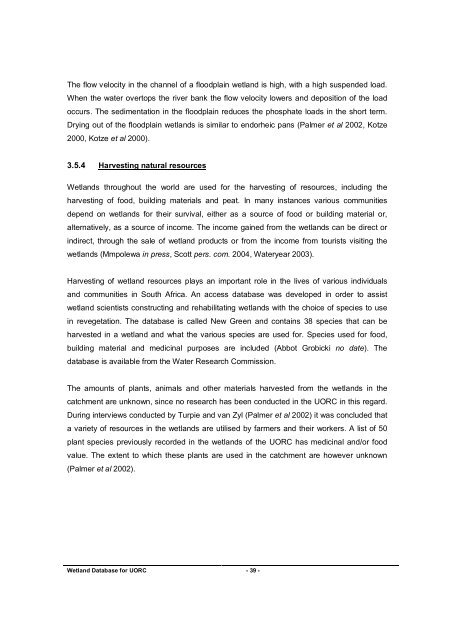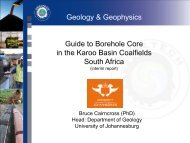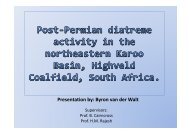coaltech upper olifants river catchment wetland inventory ...
coaltech upper olifants river catchment wetland inventory ...
coaltech upper olifants river catchment wetland inventory ...
You also want an ePaper? Increase the reach of your titles
YUMPU automatically turns print PDFs into web optimized ePapers that Google loves.
The flow velocity in the channel of a floodplain <strong>wetland</strong> is high, with a high suspended load.<br />
When the water overtops the <strong>river</strong> bank the flow velocity lowers and deposition of the load<br />
occurs. The sedimentation in the floodplain reduces the phosphate loads in the short term.<br />
Drying out of the floodplain <strong>wetland</strong>s is similar to endorheic pans (Palmer et al 2002, Kotze<br />
2000, Kotze et al 2000).<br />
3.5.4 Harvesting natural resources<br />
Wetlands throughout the world are used for the harvesting of resources, including the<br />
harvesting of food, building materials and peat. In many instances various communities<br />
depend on <strong>wetland</strong>s for their survival, either as a source of food or building material or,<br />
alternatively, as a source of income. The income gained from the <strong>wetland</strong>s can be direct or<br />
indirect, through the sale of <strong>wetland</strong> products or from the income from tourists visiting the<br />
<strong>wetland</strong>s (Mmpolewa in press, Scott pers. com. 2004, Wateryear 2003).<br />
Harvesting of <strong>wetland</strong> resources plays an important role in the lives of various individuals<br />
and communities in South Africa. An access database was developed in order to assist<br />
<strong>wetland</strong> scientists constructing and rehabilitating <strong>wetland</strong>s with the choice of species to use<br />
in revegetation. The database is called New Green and contains 38 species that can be<br />
harvested in a <strong>wetland</strong> and what the various species are used for. Species used for food,<br />
building material and medicinal purposes are included (Abbot Grobicki no date). The<br />
database is available from the Water Research Commission.<br />
The amounts of plants, animals and other materials harvested from the <strong>wetland</strong>s in the<br />
<strong>catchment</strong> are unknown, since no research has been conducted in the UORC in this regard.<br />
During interviews conducted by Turpie and van Zyl (Palmer et al 2002) it was concluded that<br />
a variety of resources in the <strong>wetland</strong>s are utilised by farmers and their workers. A list of 50<br />
plant species previously recorded in the <strong>wetland</strong>s of the UORC has medicinal and/or food<br />
value. The extent to which these plants are used in the <strong>catchment</strong> are however unknown<br />
(Palmer et al 2002).<br />
Wetland Database for UORC - 39 -




